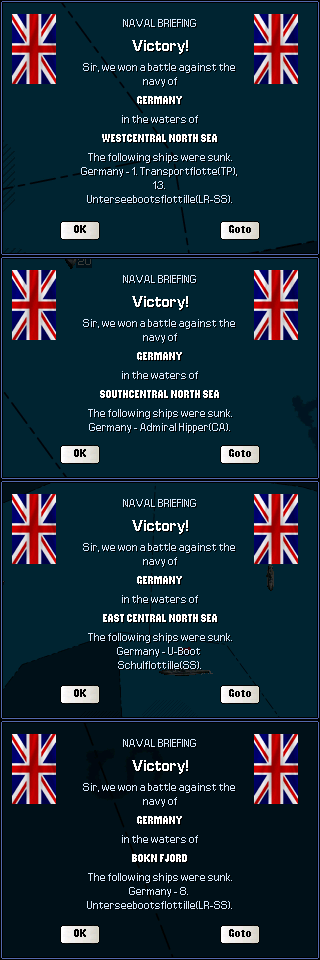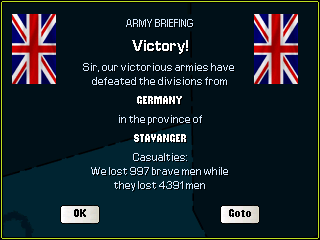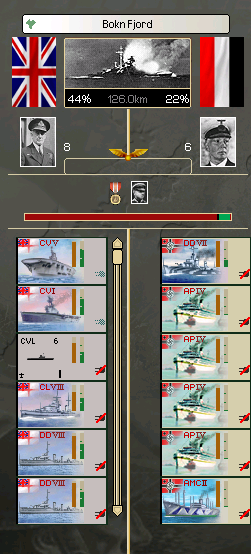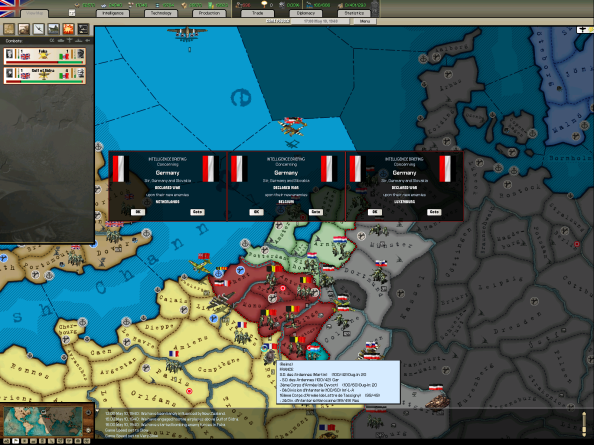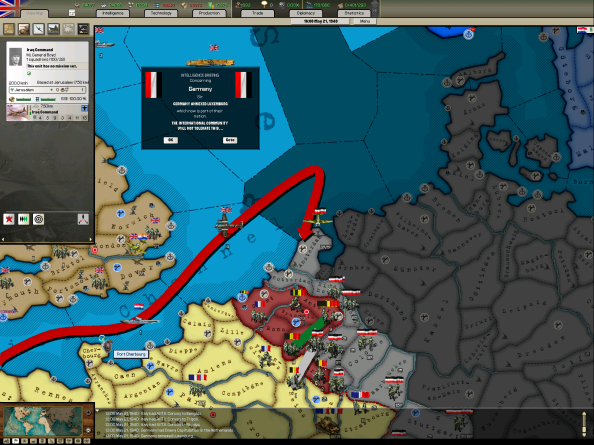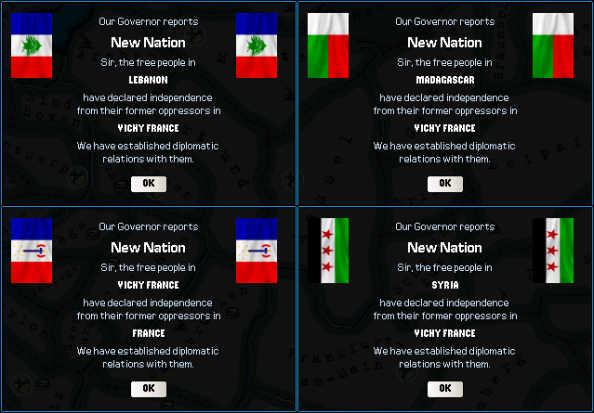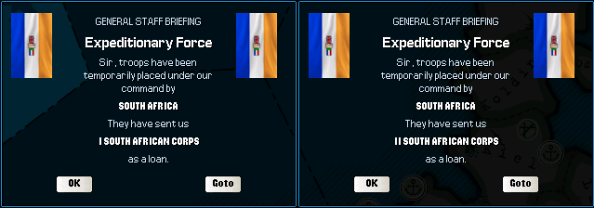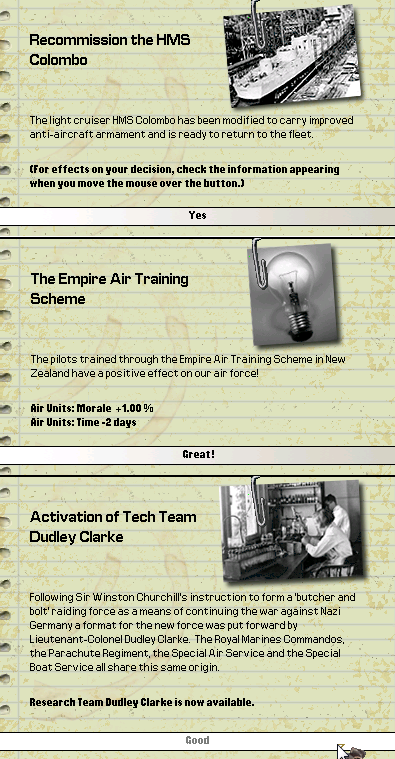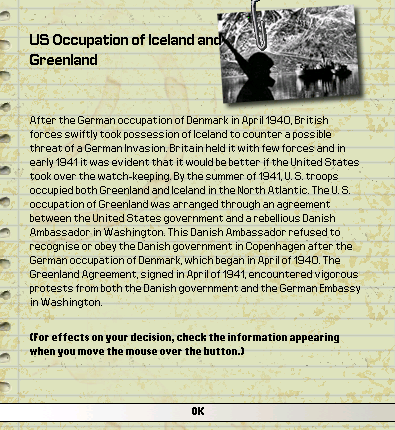Well, it’s been an eventful four months. The highlight (and low point), is Germany’s Declaration of War against Belgium, the Netherlands and poor old Luxembourg: an echo of the First World War’s Schlieffen Plan, bypassing the Martinot Line and quickly bringing France to its knees.
But first…
Norway and the Ongoing Saga in the North Sea
As ever, our brave boys have been playing cat and mouse with the Kriegsmarine in the North Sea. In the first major rumble, the Home Fleet once again encounters a German U-boat flotilla trying to head out into the North Atlantic. This is the result:
On the one hand, this is a bit of a disaster… but on the other, we have a lot of battleships. It’s not like we lost a carrier or anything.
Oops. This was an ASW group hunting down submarines off the coast of Norway. It looks as if they bit of more than they could chew. The remaining destroyer squadron has been re-assigned; Carrier Group Furious is no more.

RIP HMS Furious [editor’s note: in reality, she survived the war after seeing plenty of active duty]

RIP HMS Barham [editor’s note: in another example of our fiction mimicking fact, she was in fact sunk by a U-boat; one of only two battleshipa of the Royal Navy to suffer this fate]
Editor’s note: the sinking of HMS Barham was caught on film, and makes for shocking viewing:
Amazingly, that’s it for naval losses, at least for now. We’ve even managed a few more sinkings of our own:
Who knows what that transport flotilla was doing all the way up there? We’re not sure whether it was actually carrying troops or not. Sinking Admiral Hipper went down well though; she’s only the second German capital that we’ve sunk so far. Most of these actions were by the Home Fleet. Battle Group Hood, crewed from Gibraltar, also managed to give the Italians a bit of a kicking, at long last:
With any luck, this is just a taste of more to come.
On 25th April, the German army made their long-awaited invasion of Norway. It was short-lived. Four divisions landed in Stavanger, lured in by our light defence in the province (just one division). Things looked dicey at first, but turned decisively in our favour once the cavalry arrived:
This marks our first land-based encounter with Germany, and the lads held up well. Unfortunately for the Wehrmacht, by the time they were defeated, Carrier Group Ark Royal had driven off their transports and sent one transport flotilla to the bottom:
We must remain vigilant, of course. Germany is almost certain to try another invasion, possibly by trying to skirt further around the coast to even less defended provinces. We have not yet taken military control of Norway, but may do so if Germany successfully make a toehold.
Also in this theatre, we recently realised that the reason that the Winter War seemed to be at a standstill was because Finland and Russia changed their minds and decided to make peace soon after war was declared. Our Supreme Commander wishes his diplomats would keep him better informed.
Editor’s note: this is an interesting diversion from history, but is not likely to make much difference to the flow of the game. Still, it’s great that the game can offer these little surprises.
Herr Hitler’s Latest Treachery
The fighting between Germany and France, along their mutual border, has been going on for a while now, with little result on either side. But no more. At 17:00 on 10th May, 1940, Germany declared war simultaneously on The Netherlands, Belgium and Luxembourg:
Luxembourg and The Netherlands fall within about 10 days:
The Wehrmacht have penetrated into France by the end of May, and France finally falls on 6th July, 1940. There’s a flurry of diplomatic activity as new states are formed:
Things are becoming serious
Clearly, the loss of France is a major set-up to the Allies, even if it wasn’t totally unexpected. Germany is now huge:
The Phoney War is over. It is time for all out war and total mobilisation, and for this we need an inspiring war leader. There is only one man fit for the job:
Stirring stuff:
The most important thing here, of course, is our total mobilisation. Our industrial strength is increased dramatically. [Editor’s note: unfortunately our game is slightly out of synch with historical reality, so Churchill’s first speech is somehow given before he becomes Prime Minister.]
Immediately after the Fall of France, our allies begin to rally to our cause. South Africa are the first to get involved, giving us two divisions. More will surely follow from the free French and Belgians remaining in Africa.
Other events
A number of other events spiced up life for the British Government, as if we didn’t already have enough going on. We concluded our campaign in Ethiopia against the Italians; we will report on this separately. On the domestic front, we received another AA-cruiser conversion, had some more results from EATS and were very pleased to welcome Dudley Clark:
Clark especially is a real boon for our research efforts, being our first, and so far only, special forces expert. We’ve put him straight onto researching marine division organisation.
Around this time we are also asked to guarantee the independence of Greece, which we do, of course. This is unlikely to make much difference to the Axis powers, of course. The USSR, having forgotten about Finland, continues to pursue its belligerent policies, however, annexing all three Balkan states in quick succession. With our agreement, the US also takes over stewardship of Iceland and Greenland [editor’s note: surely the player should be offered a choice in this matter?]:
Summing up
An eventful four months! The Fall of France leaves us in a somewhat shady position in the short term, although things have been relatively quite elsewhere. Around this time our Supreme Leader realised that he had completely neglected our commitments in the Far East. Something will have to be done about that relatively quickly. More long range transports for starters. The build-up in North Africa also continues. It won’t be long before things cook off with the Italians around El Alamein.
The naval losses incurred in our naval encounters so far look like this (both Axis powers have also lost ships elsewhere):
Losses
- One MTB squadron
- Five destroyer divisions
- One County-class heavy cruiser
- Three WWI-era aircraft carriers
- Six light cruisers
- One battleship
- Three long-range and two medium range transport squadrons
German vessels sunk
- Eleven submarine squadrons
- Four destroyer squadrons
- One light cruiser
- Two heavy cruisers
- Two transport squadrons
Italian vessels sunk
- Six destroyer divisions
- One light cruiser
- One battle cruiser
So, still not brilliant, but looking up. With Germany’s domination over mainland Europe and their access to French ports on the Bay of Biscay, we certainly expect the Battle of the Atlantic to start hotting up soon.
We will report on manpower losses soon.


